Preili Museum of History and Applied Arts
The traditional Latvian costume is, in essence, the traditional festive clothing of ordinary Latvian farmers, craftsmen and fishermen, which was mostly worn in the 19th century, until about 1870. But already in the 19th century, peasant clothes became more and more similar to the clothes of townspeople and nobles, until at the end of the 19th century it was replaced by so-called city fashion clothing. From this period – end of the 19th century – the Preili Museum of History and Applied Arts owns the valuable dowry (pūrs) of Tekla Casno (1865-1950), which reflects the influence of city fashion on women’s clothing.
In the spring of the third year of museum existence in 1988 employees of the Preili Museum of History and Applied Arts went on an expedition to the present parish of Aizkalne (until 1930, Jāsmuiža). In Pirmie Pastari village, the museum staff received a real surprise at the home of pensioners Anna and Antons Kivlenieki – among the many household items made and used by A. Kivleniek’s aunt Tekla Casno and her parents Anna and Juris Casno, relatively well perserved Tekla Casno dowry was found – several ancient clothes were carefully stored by her goddaughter. The chest contained three different festive skirts (lyndraki), a beautiful tablecloth (golda pologs), a white wool shawl (villaine or placu saga) and a festive coat (burnass).
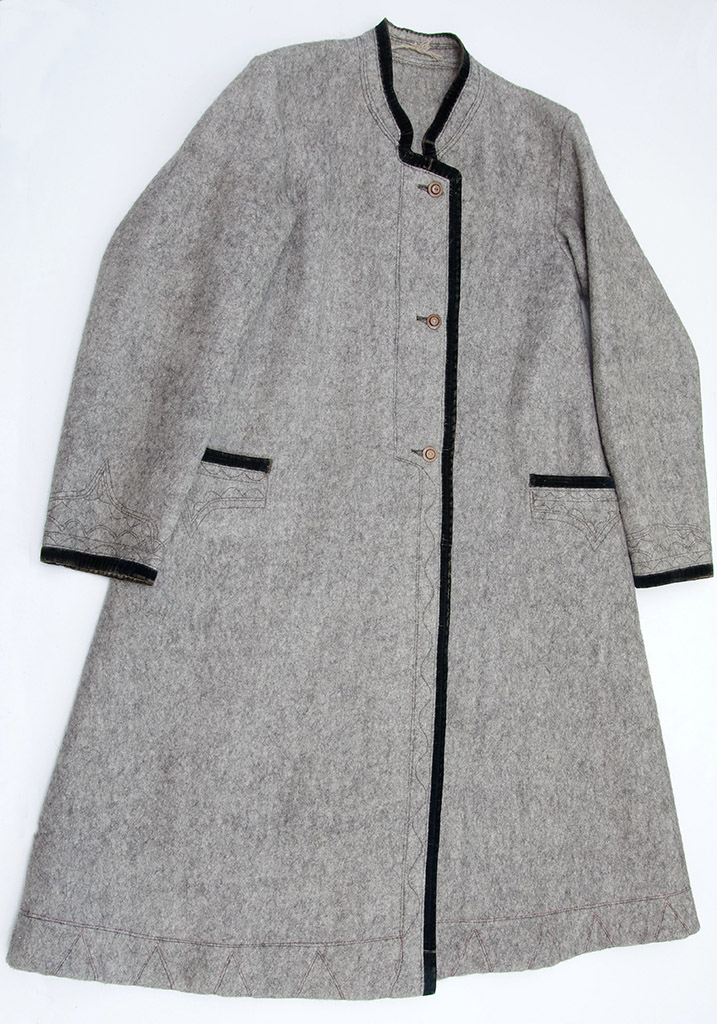
Burnass
End of the 19th century.
Festive coat or burnass made in the end of the 19th century, worn while attending the church. It is sewn with a sewing machine from a thick grey woollen cloth, without lining, with a standing collar and three small button fasteners at the front. Simple cut, one-piece back and two fronts. The ends of the sleeves, the front and the edges of the collar are decorated with black narrow velvet ribbon, the ends of the sleeves, the tops of the pockets, the front and bottom have a decorative black and red thread embroidery with an Art Nouveau influence. The coat fabric is woven in 4 threads from undyed grey sheep wool, then felted into a thick cloth. Burnass can be seen in the exposition of the Museum of History and Applied Arts of Preili “Museum Stories for Latvia”.
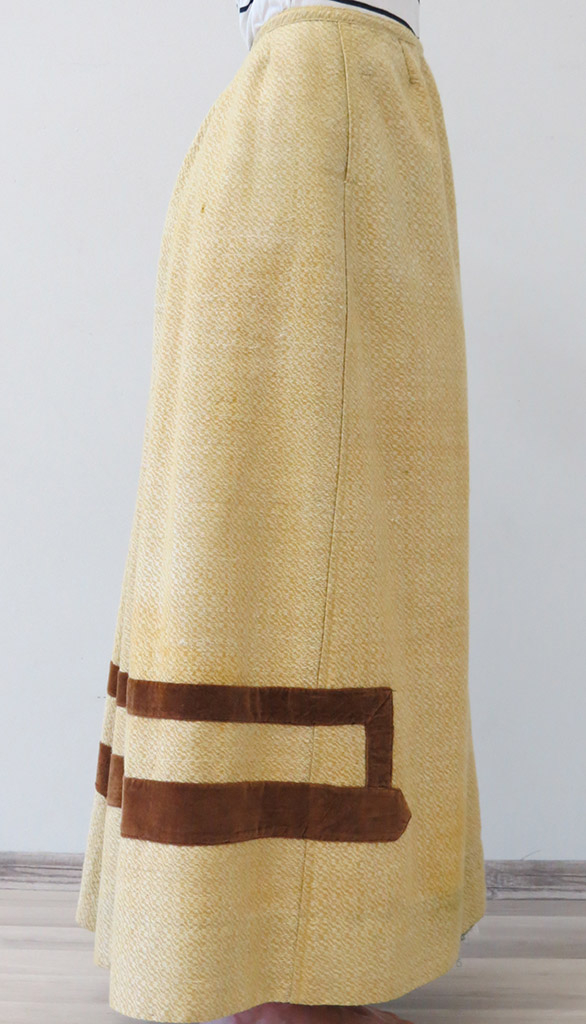
Skirt
End of the 19th century
Festive skirt, sewn from fine yellow wool fabric, decorated with brown velvet decorative stripes along the edge.
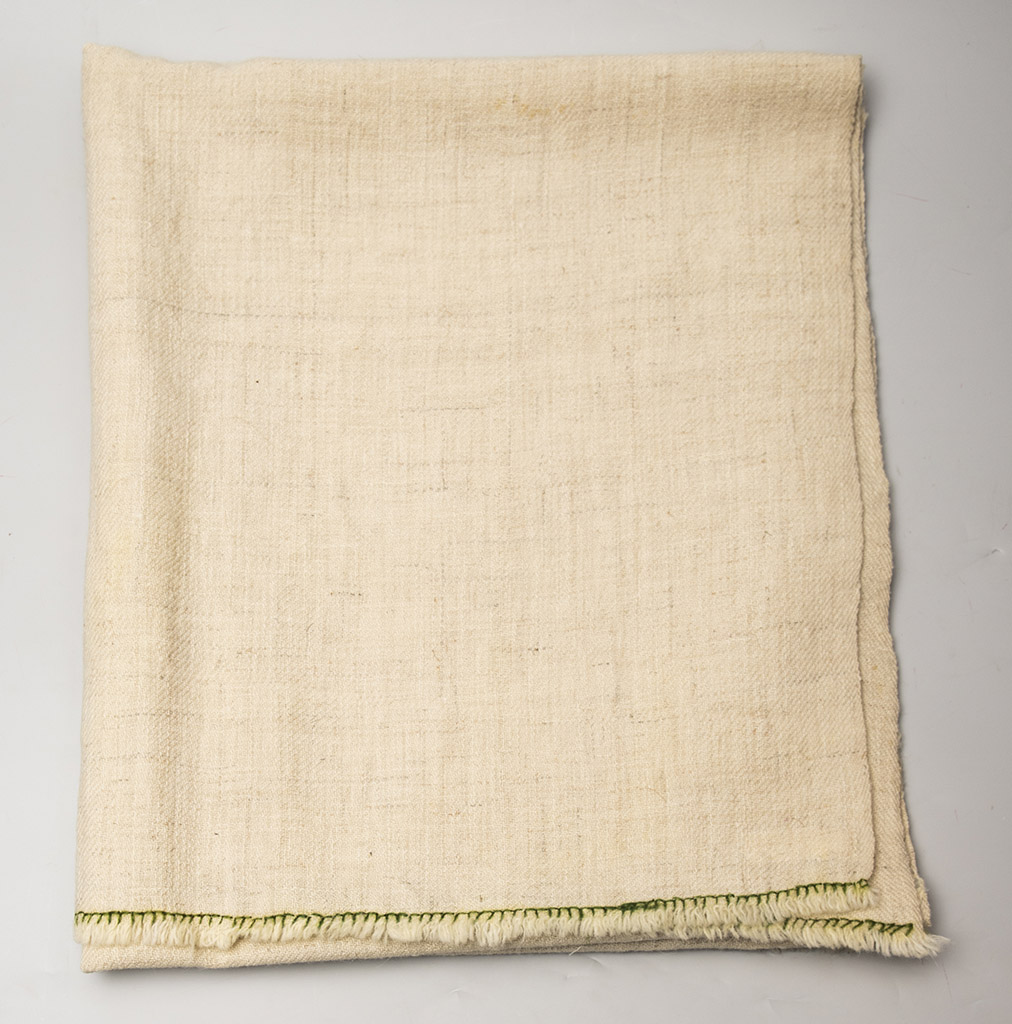
White shawl
End of the 19th century
In all regions woollen shawl was an essential part of the national dress – a rectangular or square fabric draped around the shoulders. Tekla Casno’s dowry shawl is woven from white wool threads with green ornaments at the ends.
Hrodna State Museum of the History of Religion
The clothing items that make up the traditional Belarusian costume are collected in the exhibition „Drapery”. It was started in 1975 and now there are about 1400 items in the collection. The collection is based on liturgical fabrics and liturgical clothing of different denominations. Clothes, towels, bedspreads, carpets made according to folk traditions are singled out as a separate group within the collection. Giving the elements and ornamentation of the Belarusian costume and the towels a symbolic and magical meaning, using them in rituals and ceremonies turns the Belarusian folk costume into an integral part of national beliefs. The museum collection has also been replenishing with works of modern masters made in folk traditions.
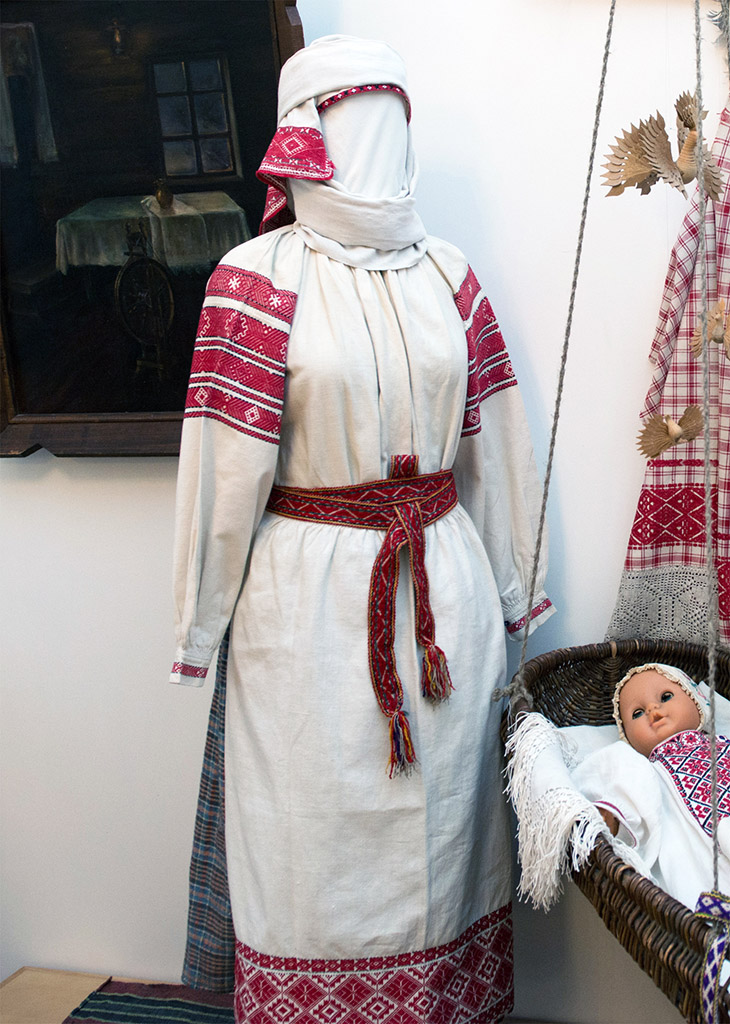
Women’s costume
Central Belarus. 1st half of the 20th century
The presented women’s costume comes from the Starodorozhsky district of the Minsk oblast and includes the following elements: andarak (a type of skirt; Belarusian word “andarak” comes from a German word “Unterrock”), an apron, a shirt, a plat (“namitka”), and a belt.
The Starodorozhsky costume is territorially related to Central Belarus, but taking into account the stylistics, archaic parts and their ornamental decoration it is close to the Polesye costume. It is characterized by harmony and balance of all elements and pale colors.
A noteworthy element of the presented costume is a headdress in the form of a strip of fabric about 280 centimeters long and about 33 centimeters wide. It is tied in a special way and is called namitka. Its presence indicates that the costume belonged to a married woman. Replacing a wreath of flowers on the bride’s head with a namit was part of the wedding ritual. It was a symbol of a change in marital status. After the wedding, the woman tied a namitka on all solemn occasions. The special role of this headdress was emphasized by the fact that its ends were richly decorated with embroidery or lace. The ornament on both edges of one item was different. The wedding namitka was kept all life and was often placed into the eternity box of the dead.
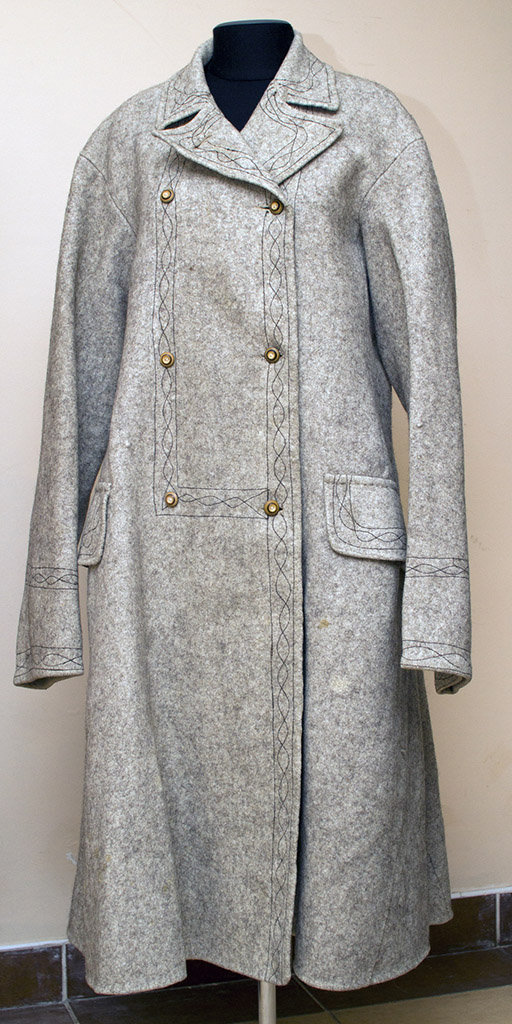
Svitka (Peasant’s russet overcoat)
the village of Tumashi, Mostovsky district. The beginning of the 20th century
Wool, cotton; weaving, felting, embroidery, hand sewing
Svitka is men’s and women’s outerwear usually below the knee length. It was used among Belarusians, Lithuanians, Russians and Ukrainians. Svitkas were usually sewn from homemade fabric of the color of sheep’s wool. It was known since the 11th century and used by different segments of the population.
Soon, the costume of Ponemanye region felt the influence of international urban fashion. It influenced the cut of the svitka: it became double-breasted, a collar and pockets appeared. Svitkas were worn until the 1930s in Belarus.
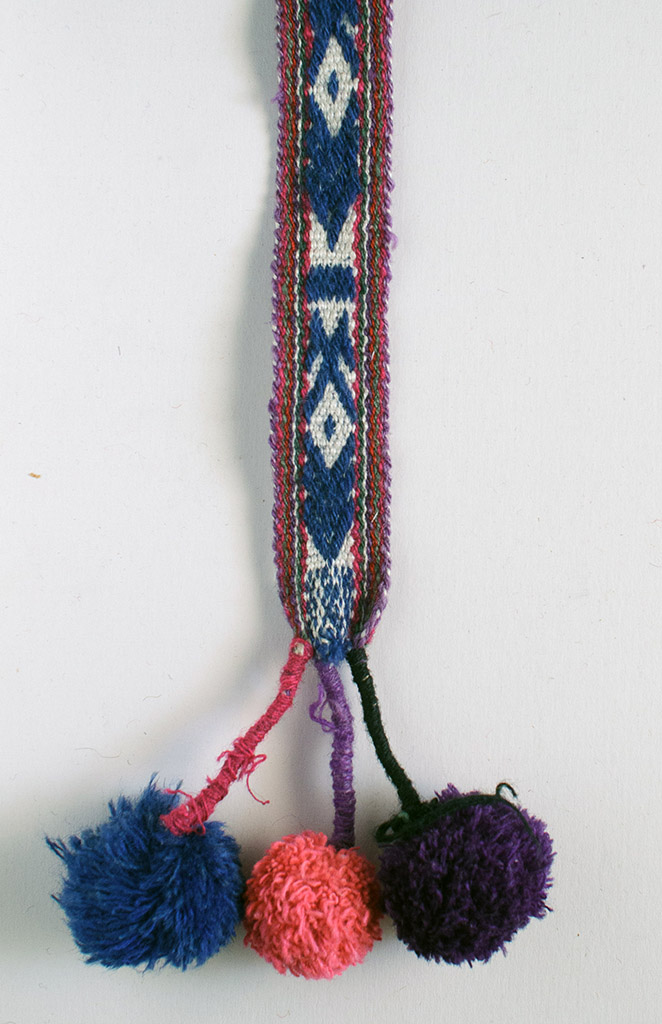
Belt
Author: Larisa Kostyukevich
Village Krasnaya, Lidsky district. 1940s
Wool, linen; weaving
A multi-colored belt was an indispensable element of the Belarusian folk costume. As a rule, it was woven, braided or knitted with tassels, fringes or pom-poms. It was one of the oldest pieces of clothing and was widely used both in everyday life and in festive costumes. The folk ethics of Belarusians regulated the norms of life that were also applied to the costume. It was considered indecent for a man to leave his house without a belt. Women could also wear aprons or aprons at their belts.
The belt was widely used in Belarusian rituals. For example , the bride tied the groom and his relatives with woven colored belts during a wedding ceremony. The presented belt was used during the wedding ceremony to decorate the icon. Belts could often be used as donations to Orthodox or Catholic churches.
Panevėžys Local Lore Museum
National costume – complete ensemble of clothing and jewelry, revealing not only regional peculiarities, but also the fashion trends of that period. Today, the national costume is an important symbol of the nation, a work skill proof of our ancestors and a reflection of their conception of beauty.
Folk costumes of western Aukštaitija region – the most archaic of Lithuanian women’s national clothes. They are bright, especially rich of white colour – white shirt, white apron and a veil, that reminds us of the Middle Ages.
Long tunic style shirts, made of home-woven thin linen canvas. Their collar, bottom of sleeves, cuffs, shoulder pieces and the chest were usually adorned with the weaving with red thread braids. Since the end of 18th century, shirts have been embroidered with a white translucent pattern. Women wore skirts on their shirts: the most ornate was the upper one; under that, they wore at least one, and sometimes several simple, coloured, and white skirts. Wool skirts were the most common woven in two-heddled square pattern. Green, red, purple, yellow colours were dominating. In the Aukštaitija region women tied white aprons on the skirts. Aprons were woven by various techniques with red (rarely blue) cotton thread braids, called “žičkai”, weaving in the bottom, finished with braids, lace or woven tassels. On the skirts and aprons, women wore braided bands. These bands are of the most archaic bands by technique, they were hand-braided of multi-coloured wool threads. Women of western Aukštaitija girded also with exquisite bands. Exquisite hundred-pattern bands were found in Aukštaitija, they were with woven diamonds, little suns, grass-snakes or other Baltic signs. Holiday vests were sewn of home-woven fabric or purchased luxury satin, velvet, brocade, damask. Favourite colours – red, green, golden yellow and silver. Married women wore veil, hats, and scarves. They wore leather sandals, richer – purchased leather shoes. Women in western Aukštaitija liked to wear silver, amber or small coral necklaces. In the cold season of the year, women wore coarse homespun overcoat, called „sermėga”; their edges, cuffs, and pockets were adorned with velvet, faux fur, or stitching. The women wrapped themselves in woolen scarves and wore patterned gloves. Both men and women wore wristbands when working outdoors and, in the woods, to keep them warm. Wristbands were knitted cuffs 4.5–19 cm length and used to wear on the wrists, colours were black, brown, red, cherry, green, blue, usually decorated with white beads.
Men’s holiday national clothes consisted of home-woven white canvas tunic-style (more often without embellishments), pants, vest and boots. Men of Aukštaitija wore linen shirt and over them non-dyed wool grey or brown coarse homespun overcoat, called „sermėga” which were seamed at the waist, with pleats folded in the back. Frock-coats, called „surdutai” sewn from the same homemade rough wool began to spread later. Summer men’s long outerwear were long shirt called “trinyčiai” (three-heddled), they were sewn from thick three-heddled woven unbleached, less frequently bleached linen or sackcloth. “Trinyčiai” were worn with tails wrapped up and tied up with band, leather belt or towel. Men wore fetro (felt wool) hats, especially popular wide-brimmed. Over shirt or pants men used to tie braided, assembled or twisted bands.
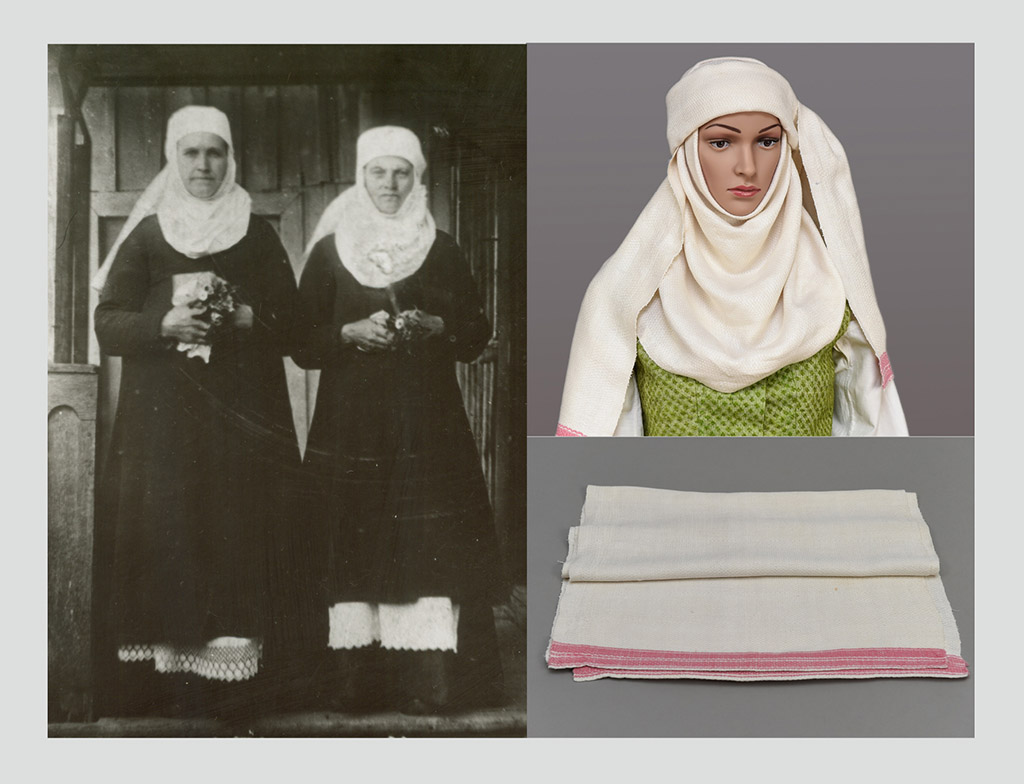
Sisters Kairytės, wearing veils, 20th century 3–4 decades. On the right – an early 20th century veil, stored in the museum’s Ethnographic Collection
Veil – one of the oldest married women’s head wear. It is already known in Aukštaitija in the 16th century. The veil was worn until the end of the 20th century. At the beginning of the 20th century, the tradition of wearing veil had already broke down, however, it was revived around 1922 by Ona Glemžienė and other women of the Kupiškis region. The veil was woven in two or eight heddles of the thinnest linen threads. It was 3-4 m long and 50-70 cm wide. The edges of the veil were decorated with interwoven red or blue cotton thread, called “žičkai“, finishing them with braids or tassels. Tying veil was an integral part of wedding ceremonies, performed by the matron of honor.
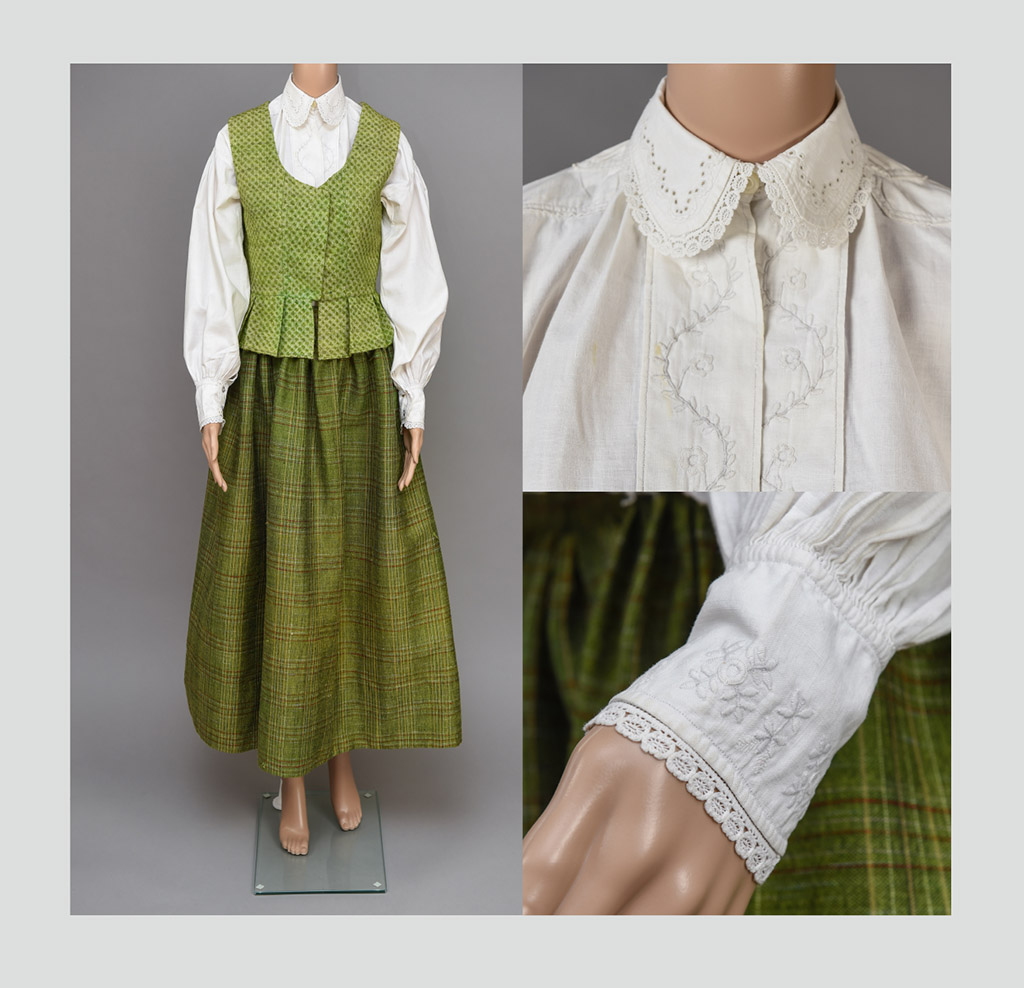
Details of women’s national clothing
The end of 20th century
The Ethnography Collection of the Panevėžys Local Lore Museum contains details of a women’s national costume received from one person – a skirt, a vest and a shirt. Skirt and vest were sewn from home woven fabric. The skirt is woven in a two-heddled square pattern, dominated by green color; white, yellow, and red threads form squares. The vest is woven in multi-heddled pattern. Women’s shirt was embroidered by hand with a white hole pattern.
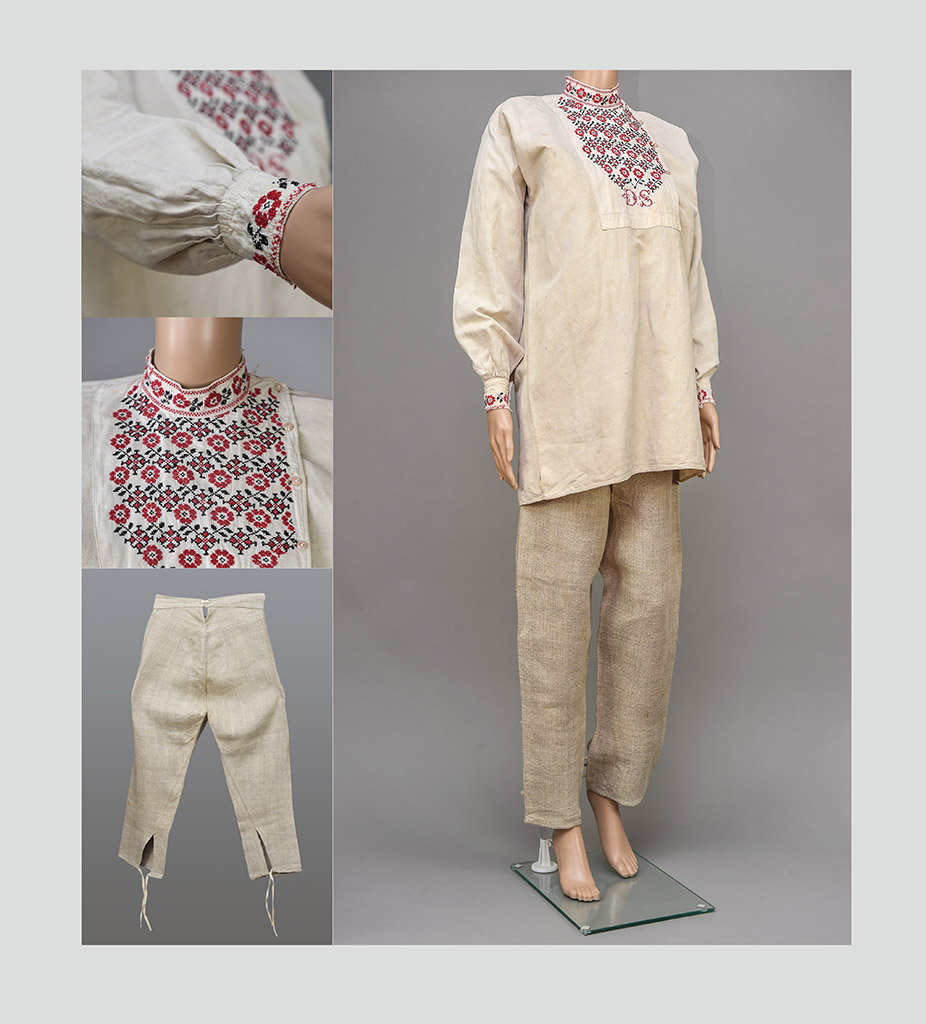
Details of men’s national clothing
Early XX century
Unlike women, Lithuanian men’s traditional clothes were much simpler. In the Ethnography collection of the Panevėžys Local Lore Museum there are stored men’s summer linen trousers which are long, with waist, sewn-on cotton strips at the ends. At the end of the 19th century and the beginning of the 20th century there were popular shirt embroidery with red and black cotton threads. The ethnographic collection includes men’s shirts with a stylized plant ornament embroidered in a cross-style on the chest, cuffs, and collar. Owner’s initials embroidered at the bottom of the chest hem.
About the project ENI-LLB-1-244 “Promotion of historical and culture cross border through museums innovations”
The project aims to build a cross border cooperation platform creating preconditions for ensuring the increasing interest of tourists and visitors about the cultural and historical heritage in the border area of Latvia, Lithuania and Belarus.
This project is funded by the European Union
Project budget: 367 864.64 EUR, EU funding 331 078.17 EUR
Project implementation period: 1st of June 2020 – 31st of May 2022
European Neighbourhood Instrument Cross-border Cooperation Programme Latvia-LithuaniaBelarus 2014-2020
https://eeas.europa.eu/delegations/belarus_en
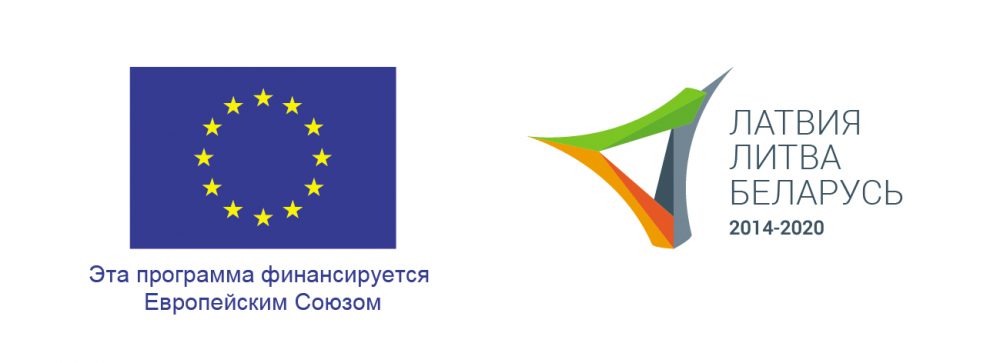
Preili Museum of History and Applied Arts (Latvia), Grodno State Museum of the History of Religion (Belarus) and Panevezys Local Lore Museum (Lithuania) joint virtual exhibition – traditional clothing.
Preili Museum of History and Applied Arts
The traditional Latvian costume is, in essence, the traditional festive clothing of ordinary Latvian farmers, craftsmen and fishermen, which was mostly worn in the 19th century, until about 1870. But already in the 19th century, peasant clothes became more and more similar to the clothes of townspeople and nobles, until at the end of the 19th century it was replaced by so-called city fashion clothing. From this period – end of the 19th century – the Preili Museum of History and Applied Arts owns the valuable dowry (pūrs) of Tekla Casno (1865-1950), which reflects the influence of city fashion on women’s clothing.
In the spring of the third year of museum existence in 1988 employees of the Preili Museum of History and Applied Arts went on an expedition to the present parish of Aizkalne (until 1930, Jāsmuiža). In Pirmie Pastari village, the museum staff received a real surprise at the home of pensioners Anna and Antons Kivlenieki – among the many household items made and used by A. Kivleniek’s aunt Tekla Casno and her parents Anna and Juris Casno, relatively well perserved Tekla Casno dowry was found – several ancient clothes were carefully stored by her goddaughter. The chest contained three different festive skirts (lyndraki), a beautiful tablecloth (golda pologs), a white wool shawl (villaine or placu saga) and a festive coat (burnass).

Burnass
End of the 19th century.
Festive coat or burnass made in the end of the 19th century, worn while attending the church. It is sewn with a sewing machine from a thick grey woollen cloth, without lining, with a standing collar and three small button fasteners at the front. Simple cut, one-piece back and two fronts. The ends of the sleeves, the front and the edges of the collar are decorated with black narrow velvet ribbon, the ends of the sleeves, the tops of the pockets, the front and bottom have a decorative black and red thread embroidery with an Art Nouveau influence. The coat fabric is woven in 4 threads from undyed grey sheep wool, then felted into a thick cloth. Burnass can be seen in the exposition of the Museum of History and Applied Arts of Preili “Museum Stories for Latvia”.

Skirt
End of the 19th century
Festive skirt, sewn from fine yellow wool fabric, decorated with brown velvet decorative stripes along the edge.

White shawl
End of the 19th century
In all regions woollen shawl was an essential part of the national dress – a rectangular or square fabric draped around the shoulders. Tekla Casno’s dowry shawl is woven from white wool threads with green ornaments at the ends.
Hrodna State Museum of the History of Religion
The clothing items that make up the traditional Belarusian costume are collected in the exhibition „Drapery”. It was started in 1975 and now there are about 1400 items in the collection. The collection is based on liturgical fabrics and liturgical clothing of different denominations. Clothes, towels, bedspreads, carpets made according to folk traditions are singled out as a separate group within the collection. Giving the elements and ornamentation of the Belarusian costume and the towels a symbolic and magical meaning, using them in rituals and ceremonies turns the Belarusian folk costume into an integral part of national beliefs. The museum collection has also been replenishing with works of modern masters made in folk traditions.

Women’s costume
Central Belarus. 1st half of the 20th century
The presented women’s costume comes from the Starodorozhsky district of the Minsk oblast and includes the following elements: andarak (a type of skirt; Belarusian word “andarak” comes from a German word “Unterrock”), an apron, a shirt, a plat (“namitka”), and a belt.
The Starodorozhsky costume is territorially related to Central Belarus, but taking into account the stylistics, archaic parts and their ornamental decoration it is close to the Polesye costume. It is characterized by harmony and balance of all elements and pale colors.
A noteworthy element of the presented costume is a headdress in the form of a strip of fabric about 280 centimeters long and about 33 centimeters wide. It is tied in a special way and is called namitka. Its presence indicates that the costume belonged to a married woman. Replacing a wreath of flowers on the bride’s head with a namit was part of the wedding ritual. It was a symbol of a change in marital status. After the wedding, the woman tied a namitka on all solemn occasions. The special role of this headdress was emphasized by the fact that its ends were richly decorated with embroidery or lace. The ornament on both edges of one item was different. The wedding namitka was kept all life and was often placed into the eternity box of the dead.

Svitka (Peasant’s russet overcoat)
the village of Tumashi, Mostovsky district. The beginning of the 20th century
Wool, cotton; weaving, felting, embroidery, hand sewing
Svitka is men’s and women’s outerwear usually below the knee length. It was used among Belarusians, Lithuanians, Russians and Ukrainians. Svitkas were usually sewn from homemade fabric of the color of sheep’s wool. It was known since the 11th century and used by different segments of the population.
Soon, the costume of Ponemanye region felt the influence of international urban fashion. It influenced the cut of the svitka: it became double-breasted, a collar and pockets appeared. Svitkas were worn until the 1930s in Belarus.

Belt
Author: Larisa Kostyukevich
Village Krasnaya, Lidsky district. 1940s
Wool, linen; weaving
A multi-colored belt was an indispensable element of the Belarusian folk costume. As a rule, it was woven, braided or knitted with tassels, fringes or pom-poms. It was one of the oldest pieces of clothing and was widely used both in everyday life and in festive costumes. The folk ethics of Belarusians regulated the norms of life that were also applied to the costume. It was considered indecent for a man to leave his house without a belt. Women could also wear aprons or aprons at their belts.
The belt was widely used in Belarusian rituals. For example , the bride tied the groom and his relatives with woven colored belts during a wedding ceremony. The presented belt was used during the wedding ceremony to decorate the icon. Belts could often be used as donations to Orthodox or Catholic churches.
Panevėžys Local Lore Museum
National costume – complete ensemble of clothing and jewelry, revealing not only regional peculiarities, but also the fashion trends of that period. Today, the national costume is an important symbol of the nation, a work skill proof of our ancestors and a reflection of their conception of beauty.
Folk costumes of western Aukštaitija region – the most archaic of Lithuanian women’s national clothes. They are bright, especially rich of white colour – white shirt, white apron and a veil, that reminds us of the Middle Ages.
Long tunic style shirts, made of home-woven thin linen canvas. Their collar, bottom of sleeves, cuffs, shoulder pieces and the chest were usually adorned with the weaving with red thread braids. Since the end of 18th century, shirts have been embroidered with a white translucent pattern. Women wore skirts on their shirts: the most ornate was the upper one; under that, they wore at least one, and sometimes several simple, coloured, and white skirts. Wool skirts were the most common woven in two-heddled square pattern. Green, red, purple, yellow colours were dominating. In the Aukštaitija region women tied white aprons on the skirts. Aprons were woven by various techniques with red (rarely blue) cotton thread braids, called “žičkai”, weaving in the bottom, finished with braids, lace or woven tassels. On the skirts and aprons, women wore braided bands. These bands are of the most archaic bands by technique, they were hand-braided of multi-coloured wool threads. Women of western Aukštaitija girded also with exquisite bands. Exquisite hundred-pattern bands were found in Aukštaitija, they were with woven diamonds, little suns, grass-snakes or other Baltic signs. Holiday vests were sewn of home-woven fabric or purchased luxury satin, velvet, brocade, damask. Favourite colours – red, green, golden yellow and silver. Married women wore veil, hats, and scarves. They wore leather sandals, richer – purchased leather shoes. Women in western Aukštaitija liked to wear silver, amber or small coral necklaces. In the cold season of the year, women wore coarse homespun overcoat, called „sermėga”; their edges, cuffs, and pockets were adorned with velvet, faux fur, or stitching. The women wrapped themselves in woolen scarves and wore patterned gloves. Both men and women wore wristbands when working outdoors and, in the woods, to keep them warm. Wristbands were knitted cuffs 4.5–19 cm length and used to wear on the wrists, colours were black, brown, red, cherry, green, blue, usually decorated with white beads.
Men’s holiday national clothes consisted of home-woven white canvas tunic-style (more often without embellishments), pants, vest and boots. Men of Aukštaitija wore linen shirt and over them non-dyed wool grey or brown coarse homespun overcoat, called „sermėga” which were seamed at the waist, with pleats folded in the back. Frock-coats, called „surdutai” sewn from the same homemade rough wool began to spread later. Summer men’s long outerwear were long shirt called “trinyčiai” (three-heddled), they were sewn from thick three-heddled woven unbleached, less frequently bleached linen or sackcloth. “Trinyčiai” were worn with tails wrapped up and tied up with band, leather belt or towel. Men wore fetro (felt wool) hats, especially popular wide-brimmed. Over shirt or pants men used to tie braided, assembled or twisted bands.

Sisters Kairytės, wearing veils, 20th century 3–4 decades. On the right – an early 20th century veil, stored in the museum’s Ethnographic Collection
Veil – one of the oldest married women’s head wear. It is already known in Aukštaitija in the 16th century. The veil was worn until the end of the 20th century. At the beginning of the 20th century, the tradition of wearing veil had already broke down, however, it was revived around 1922 by Ona Glemžienė and other women of the Kupiškis region. The veil was woven in two or eight heddles of the thinnest linen threads. It was 3-4 m long and 50-70 cm wide. The edges of the veil were decorated with interwoven red or blue cotton thread, called “žičkai“, finishing them with braids or tassels. Tying veil was an integral part of wedding ceremonies, performed by the matron of honor.

Details of women’s national clothing
The end of 20th century
The Ethnography Collection of the Panevėžys Local Lore Museum contains details of a women’s national costume received from one person – a skirt, a vest and a shirt. Skirt and vest were sewn from home woven fabric. The skirt is woven in a two-heddled square pattern, dominated by green color; white, yellow, and red threads form squares. The vest is woven in multi-heddled pattern. Women’s shirt was embroidered by hand with a white hole pattern.

Details of men’s national clothing
Early XX century
Unlike women, Lithuanian men’s traditional clothes were much simpler. In the Ethnography collection of the Panevėžys Local Lore Museum there are stored men’s summer linen trousers which are long, with waist, sewn-on cotton strips at the ends. At the end of the 19th century and the beginning of the 20th century there were popular shirt embroidery with red and black cotton threads. The ethnographic collection includes men’s shirts with a stylized plant ornament embroidered in a cross-style on the chest, cuffs, and collar. Owner’s initials embroidered at the bottom of the chest hem.
About the project ENI-LLB-1-244 “Promotion of historical and culture cross border through museums innovations”
The project aims to build a cross border cooperation platform creating preconditions for ensuring the increasing interest of tourists and visitors about the cultural and historical heritage in the border area of Latvia, Lithuania and Belarus.
This project is funded by the European Union
Project budget: 367 864.64 EUR, EU funding 331 078.17 EUR
Project implementation period: 1st of June 2020 – 31st of May 2022
European Neighbourhood Instrument Cross-border Cooperation Programme Latvia-LithuaniaBelarus 2014-2020
https://eeas.europa.eu/delegations/belarus_en
